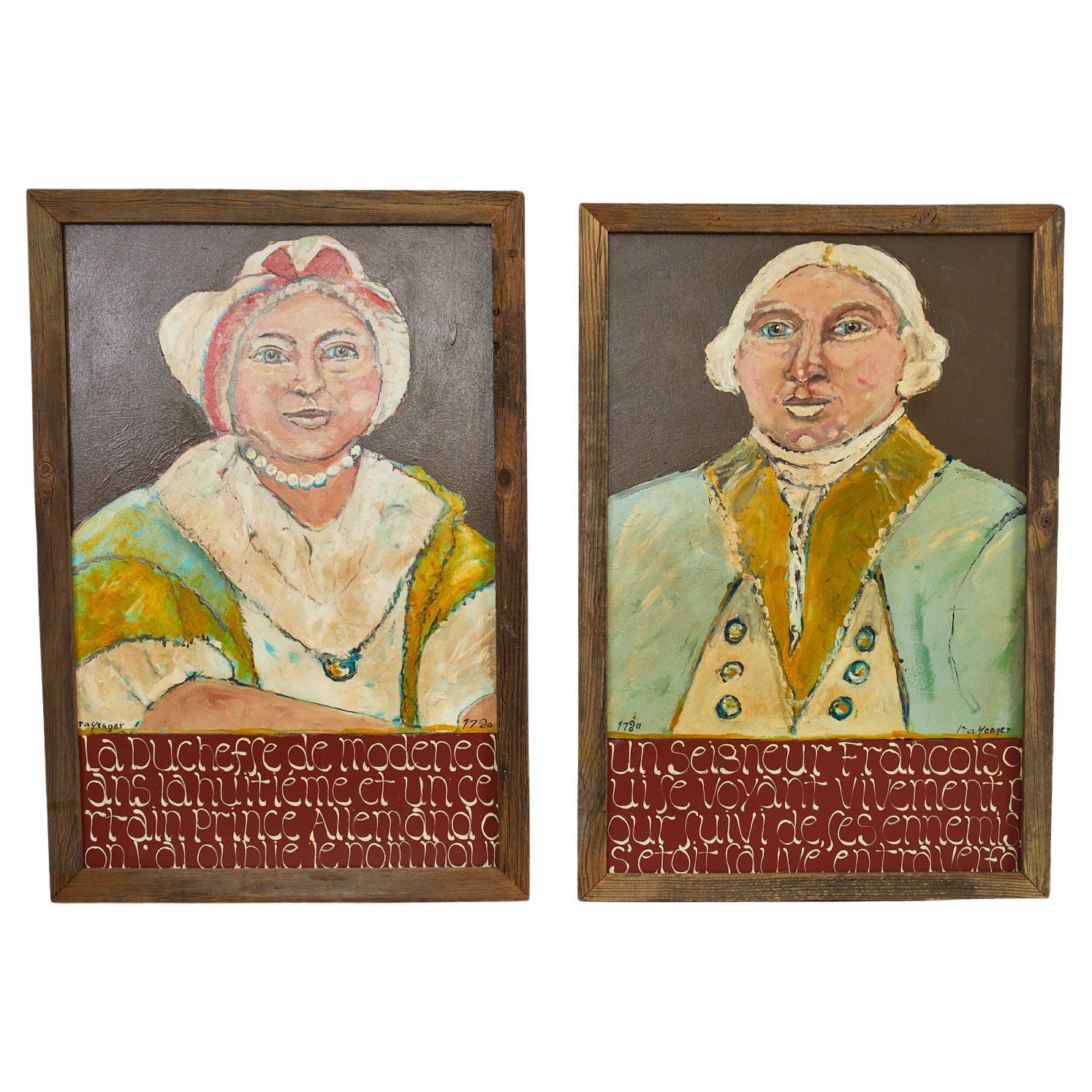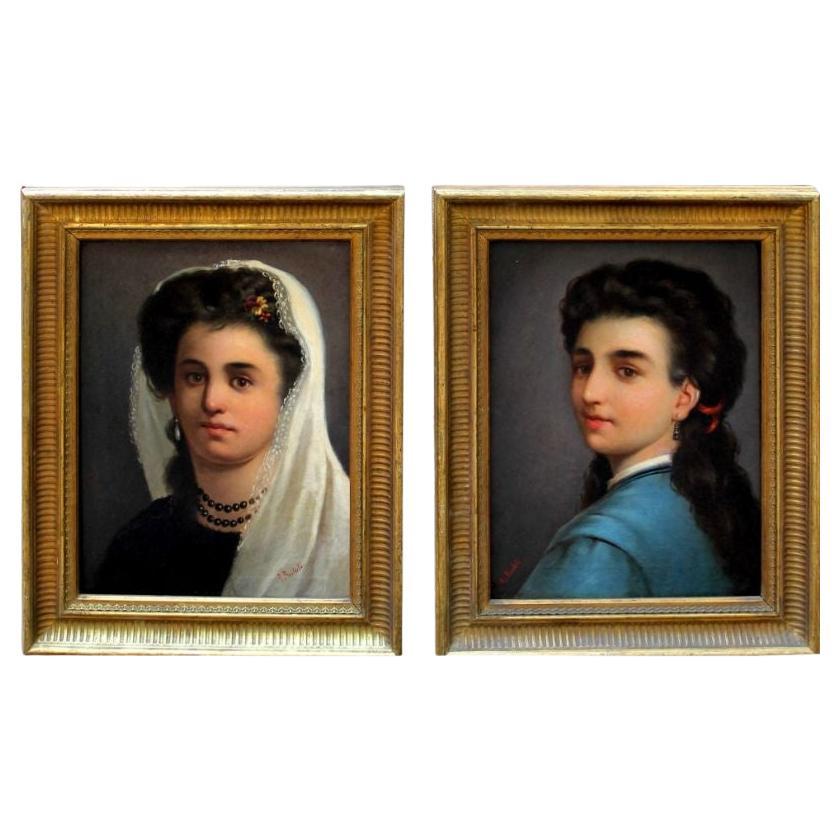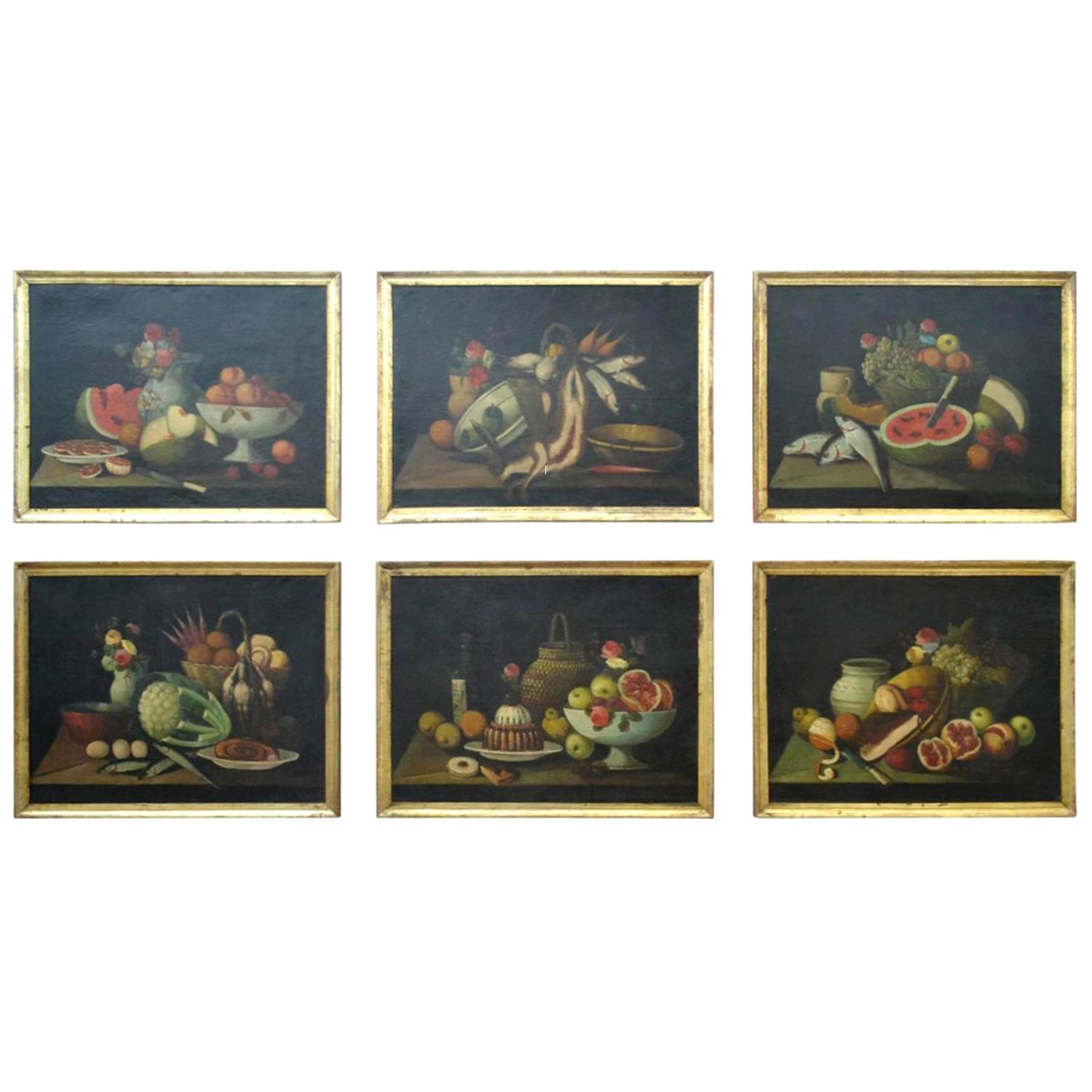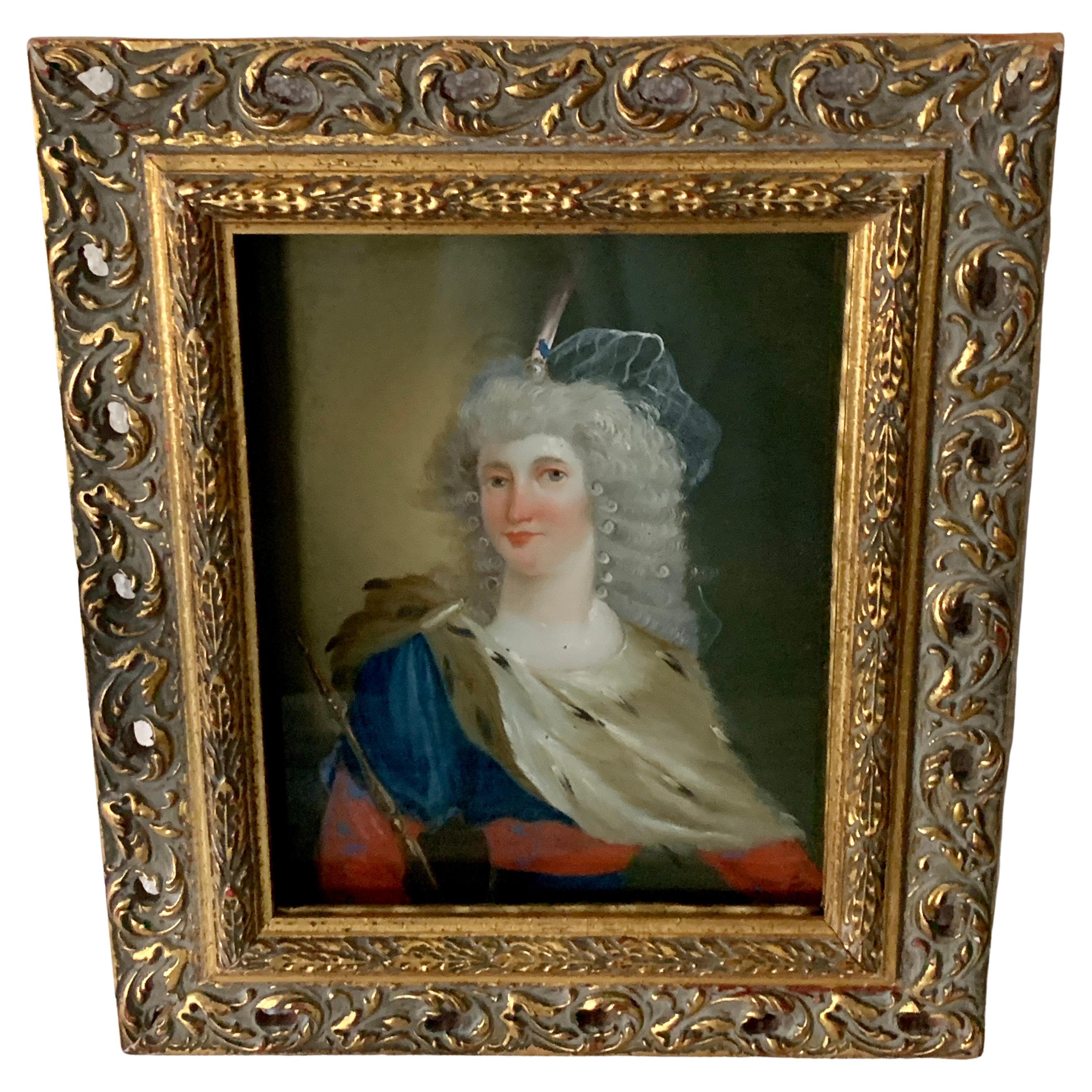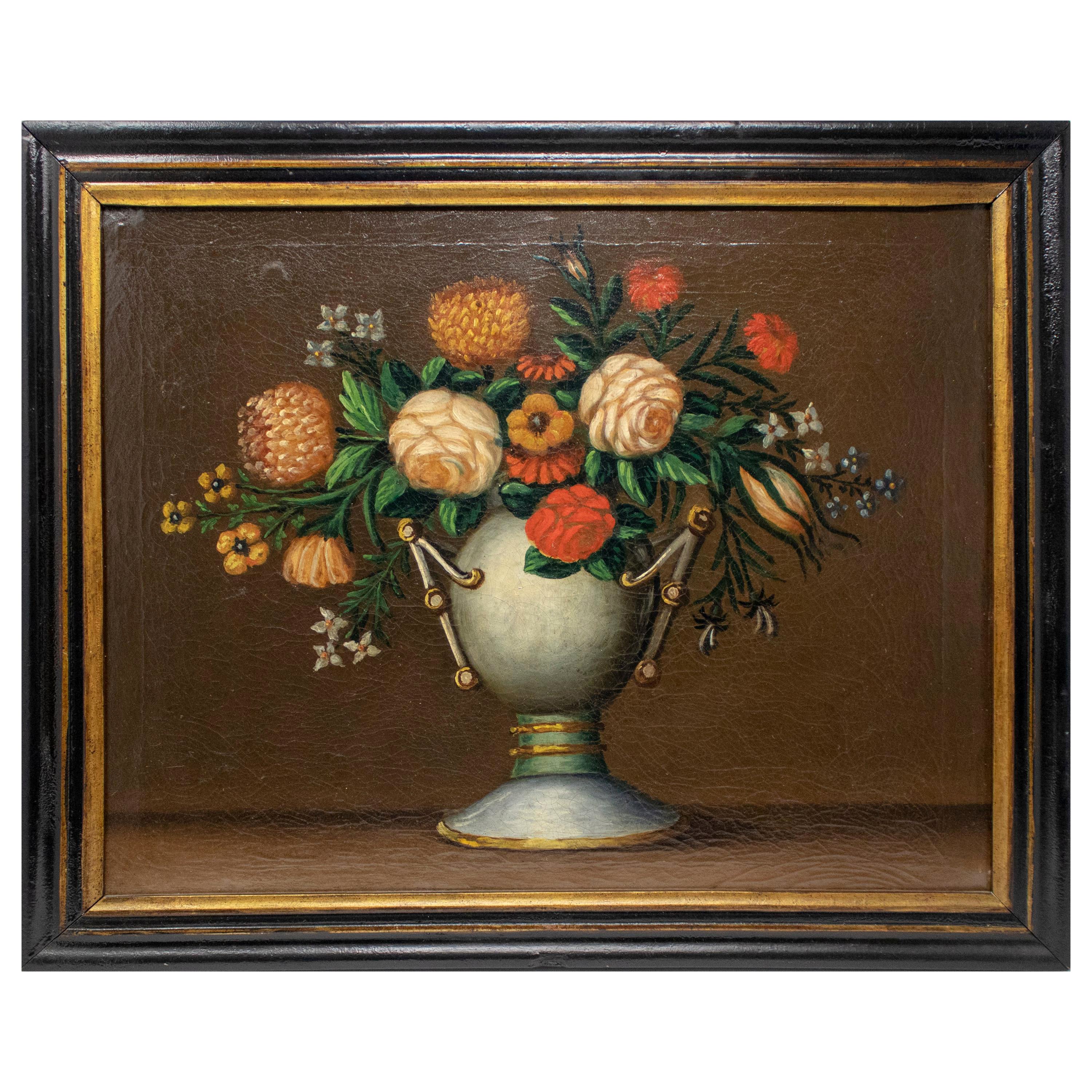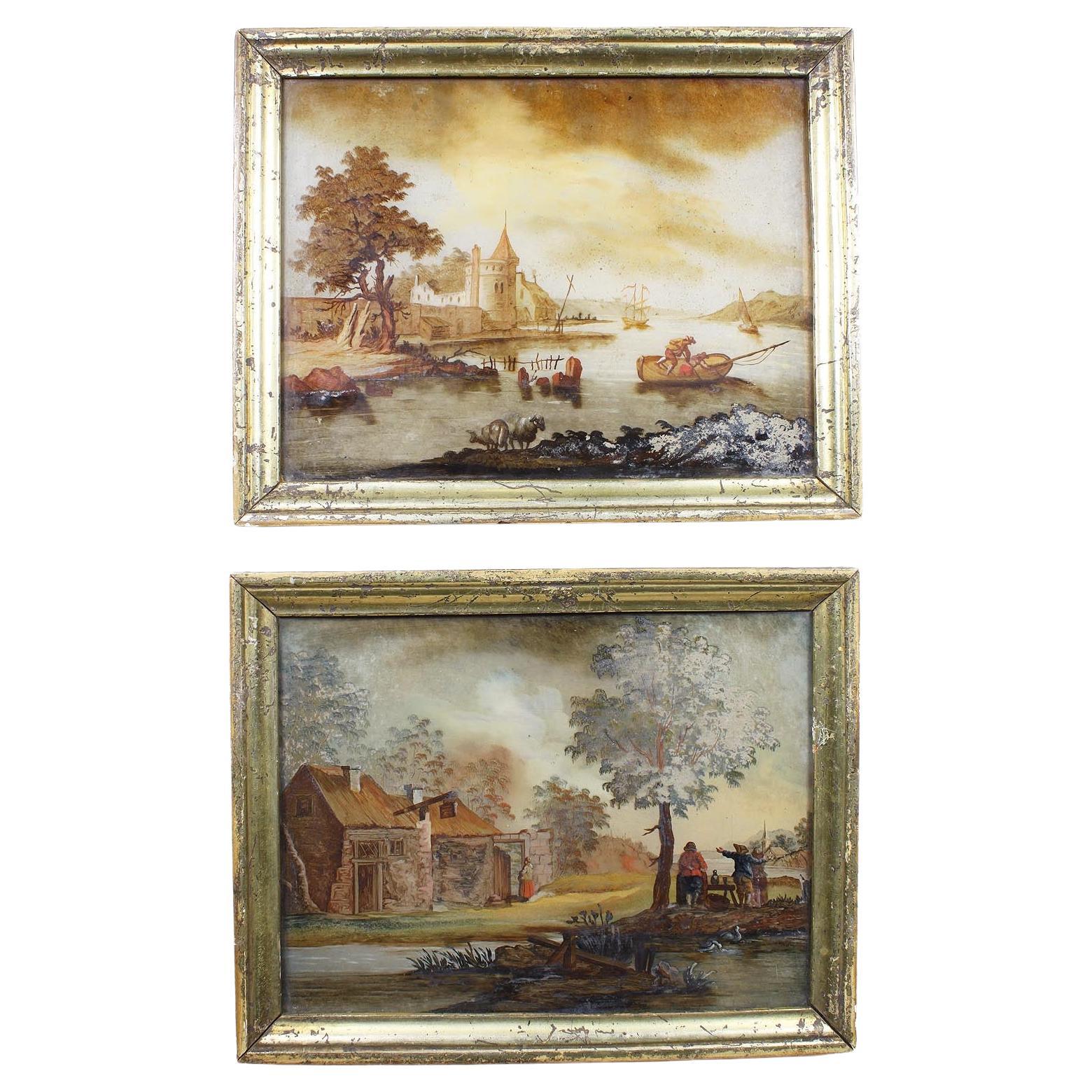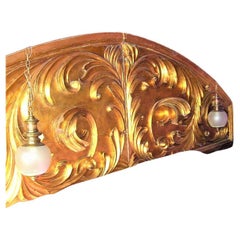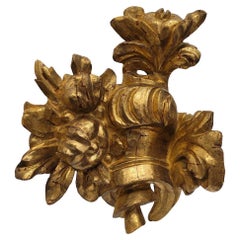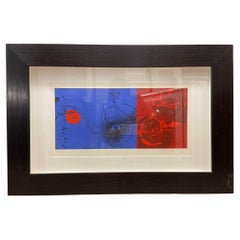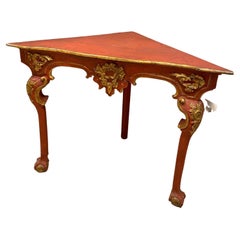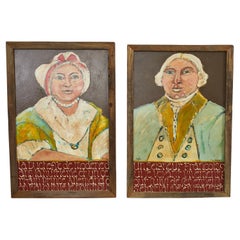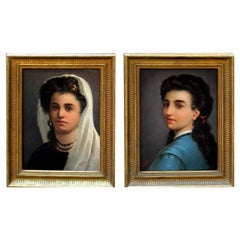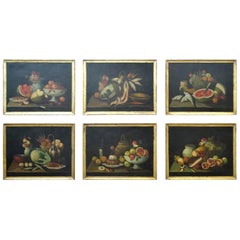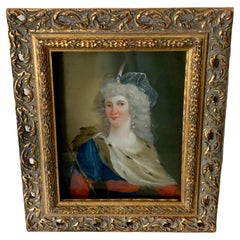Items Similar to 18th Century Spanish Painting on the Glass, Couple of Painting, Gildwood Frame
Want more images or videos?
Request additional images or videos from the seller
1 of 21
18th Century Spanish Painting on the Glass, Couple of Painting, Gildwood Frame
About the Item
Amazing pair of baroque cornucopias, with painted glass, s. XVIII, Spanish origin, Andalusian school (Córdoba)
Outstanding pair of Cornucopias in carved wood and gilwood decorated with the baroque aesthetic of scrolls and undulating motifs. Each piece awaits an original painted glass.
They are made following the aesthetic parameters of the Spanish School at the end of the 18th century.
The subjects represented, with great realism and naturalness, are a scene of Saint Anne with the Virgin Mary as a child (the glass support, as can be seen in the images, is damaged at the bottom, without influencing the scene); and the other painted glass has Saint Catherine of Alexandria, with the attributes of her iconography such as the cross and the serpent.
They preserve the original frame of excellent workmanship because the different scrolls are elegantly arranged and it also has the shell of Santiago in the upper part. In the back you can see the wrought iron structure that has been designed to support such a voluptuous ornament. In addition, you can perfectly observe the technique that has been used traditionally for centuries to gild wood, since the ancient gilders first applied an ocher-colored clay treatment (bowl) so that the gold leaf placed on top, 24 quilts, may have a more golden color that would otherwise be impossible to achieve. It is an exclusive piece, of great quality.
It has some flaws that have been carefully indicated in the images, something typical of the passage of time and with the time and use
Special packaging is included to preserve the pieces during transport. Tracking number and insurance.
Total measurements: 86cm (height) x 58cm (width) x 7cm (depth)
Measurements of each glass: 29cm (height) x 21.5cm (width)
- Dimensions:Height: 33.86 in (86 cm)Width: 22.84 in (58 cm)Depth: 2.76 in (7 cm)
- Sold As:Set of 2
- Style:Baroque (Of the Period)
- Materials and Techniques:
- Period:1780-1789
- Date of Manufacture:1780
- Condition:Wear consistent with age and use.
- Seller Location:Valladolid, ES
- Reference Number:1stDibs: LU2943327230942
About the Seller
4.7
Gold Seller
Premium sellers maintaining a 4.3+ rating and 24-hour response times
Established in 1990
1stDibs seller since 2017
158 sales on 1stDibs
Typical response time: <1 hour
- ShippingRetrieving quote...Shipping from: Valladolid, Spain
- Return Policy
Authenticity Guarantee
In the unlikely event there’s an issue with an item’s authenticity, contact us within 1 year for a full refund. DetailsMoney-Back Guarantee
If your item is not as described, is damaged in transit, or does not arrive, contact us within 7 days for a full refund. Details24-Hour Cancellation
You have a 24-hour grace period in which to reconsider your purchase, with no questions asked.Vetted Professional Sellers
Our world-class sellers must adhere to strict standards for service and quality, maintaining the integrity of our listings.Price-Match Guarantee
If you find that a seller listed the same item for a lower price elsewhere, we’ll match it.Trusted Global Delivery
Our best-in-class carrier network provides specialized shipping options worldwide, including custom delivery.More From This Seller
View All18th Century Spanish Altarpiece, Wallmounted Sculpture, Carved Gilwood
Located in Valladolid, ES
One of a kind Set of two pieces belonging to a monumental Baroque altarpiece made in the 18th century.
These are two magnificent carvings of large dimensions, which together make a semicircular piece with a profuse decoration also of monumental proportions of plant forms.
Decoration with elaborate carved rolls, which stand out from the general structure. It comes from a Spanish church that housed an imposing altarpiece made in the second half of the 18th century.
The entire visible surface is gilded with original gold leaf, with imperceptible subsequent touch-ups. The back is reinforced, which makes the pieces very strong and heavy.
In the photographs you can see the approach of its collectors: they placed it as a headboard, it looked impressive! But these exclusive pieces can be presented in many possible ways, either as part of the wall or as a work of art.
Due to its enormous size, the configuration chosen for transport is "the buyer picks up the piece" but if, once awarded, you want to contract transport, we will provide it (we have a team of experts).
Total measurements: 450 cm (width) x 160cm (height) x 25cm (depth)
Measurements of each piece (2): 225cm (width) x 160cm (height) x 25cm (depth)
It is a unique opportunity to acquire two exclusive pieces in the world of antiques.
Category
Antique Late 18th Century Spanish Baroque Figurative Sculptures
Materials
Wood, Giltwood
$7,060 Sale Price
38% Off
Spanish Baroque Carved gilded wood Fragment of altarpiece
By Soft Baroque
Located in Valladolid, ES
Exceptional fragment of a baroque altarpiece in carved and gilded wood. The technique used in the conception of this piece is exceptional, the different elements have been devastated...
Category
Antique 1780s Spanish Baroque Decorative Art
Materials
Gold Leaf
$1,309 Sale Price
20% Off
Korea Etching by Deok Sung Kang, numbered 75/75
By Duck Shin
Located in Valladolid, ES
Gorgeous Etching, with aquatint and color matrix by the South Korean artist Deok Sung Kang, made around 1990. The works of this artist, although they tend towards abstraction, are really inspired by nature. They illustrate a very personal vision of everyday objects and phenomena. The creative brilliance of this artist is widely recognized.
In this case, the work is divided into two areas, the first of which is dominated by a red color, which represents a pair of red roses using a rather realistic technique. However, in contrast, a larger area of intense blue inspired by natural motifs and splashed with a red spot.
About the artist
Deok Sung Kang is a painter and printmaker of South Korean origin. He studied Fine Arts in his native country, although he later attended the École de Beaux Arts in Paris and, later, in 1989, he settled in Madrid, where he continued his studies at the Complutense University of Madrid. The highlight of his facet as a painter are his prints, often using rice paper as a support.
Most of his works have been exhibited at fairs and exhibitions in Spain, but he has also done some in his country, such as at the Art Museum in Seoul.
About the technique
The origin of prints in Asian art has its foundations in the knowledge of printing texts on woodblocks, around the 8th century. Over time, it evolved and this new art became accessible to the majority of the public, opening the doors to the enjoyment of art and collecting, which until then was limited only to merchants, rich warriors...
Gprgeous Etching is a type of engraving, which is made using a metal plate (iron, zinc or copper) as a base, which is covered with a light layer of a protective varnish or acid-resistant wax. The engraver draws with a stylus on the layer of varnish, reaching just up to the metal plate. Later, the plate is dipped in etching, hence its name, a solution based on water and nitric acid, which corrodes the copper in the areas where it was not protected by the varnish. The immersion time is what determines the depth of the line.
Metal plates engraved with this technique can be printed with the desired ink colour, prepared by combining various pigments and binders.
Beautiful work of art by the contemporary Korean artist Duck Sung Kang...
Category
1990s Korean Mid-Century Modern Paintings
Materials
Paper
$735 Sale Price
20% Off
18th Century Spanish Red Corner Table, Console, Andalusian Baroque
By Soft Baroque
Located in Valladolid, ES
Outstanding piece representative of Spanish Baroque Art. It has a corner Console , the polychromy is the original, preserved in Venetian red, which...
Category
Antique 1780s Spanish Baroque Console Tables
Materials
Gold Leaf
$2,447 Sale Price
53% Off
Catalan School Large Painting "The Walk" Oil on canvas , Romantic style
By Mary Spain
Located in Valladolid, ES
“The walk”, Lluís Muntané Muns, Catalan School, pp. 20th century - Spain
Technique on support: oil on canvas
Title of the work: “The Walk”
Author: Lluís Muntané Muns (1899 - 1987)
Style/School: Catalan School
Period: first half of the 20th century
Country of origin: Catalonia, Spain
Origin: Banco Santander
Some damage visible in the photographs and that could be restored
Dimensions: 204 x 343 cm.
One of a kind and Large oil on canvas signed by Lluís Muntané Muns depicting a pleasant everyday scene, aristocrats and bourgeois taking a walk along a wide avenue. The ladies with their elegant dresses and parasols and the men with long coats.
This work is unique, not only for its pictorial quality in such a large, almost muralist size, but for its traceability, it was commissioned at the beginning of the 20th century and includes a bank building from the end and beginning of the 20th century in Latin America.
The composition is divided into a horizontal strip in the lower half in which the different characters are arranged, conversing with each other, flanked by the trees that appear at the ends. Behind them, in the center of the composition rises a large neoclassical-style building that escapes towards the landscape that can be seen in the background.
Lluís Muntané Muns opted for a realistic academicism, of high quality but with sober and static expression, which is also reminiscent of some of the characteristics of Catalan noucentisme. Although most of his career was dedicated to portraits, he also cultivated muralism. A lover of chiaroscuro, he managed to provide warmth to his plastic environments with an equally elegant and contained palette. His compositions are always well constructed and have the elegance that seems a dominant note in all aspects of his work.
Noucentisme or Novencentism designates a cultural movement that began in 1906 in Catalonia (propounded by Eugenio d'Ors), claiming the need for a classicism with a sense of modernity, but that was at the same time linked to tradition, given its nationalist mood. . Catalan identity linked to the classic substratum of Catalonia and its connection with the Mediterranean. He wanted to break with the cosmopolitan character of Modernism and the transience of Impressionism. He set out to achieve a more objective, constant and, ultimately, eternal art. For this, the idea of the “classical” (but never an explicit copy of said period) and the “Mediterranean” was used and the way to capture it in painting was through static, balanced, and simple compositions. It must be pointed out that it cannot be understood as a style, but as a series of ideas that each artist understands in his own way.
In this case, the memory of noucentisme is appreciated above all in the composition: a feeling of serenity, proportion, the figures do not present very exaggerated or grandiose movements... It attempts to represent the eternal through compositional balance. The colors seem muted because this effect was sought, since they understood classicism as something serene and balanced.
Lluís Muntané Muns (Mataró, Barcelona, 1899 – Barcelona, 1987)
A disciple of Vicente Borrás and José...
Category
Vintage 1920s Spanish Romantic Paintings
Materials
Canvas, Paint, Wood
$4,429 Sale Price
35% Off
French landscape painting by René Genis green “The alley of the cypresses”
By René Genis
Located in Valladolid, ES
One of a kind and very beautiful work by René Genis, a French painter known for his serene and poetic style, depicts a sown field from an unusual perspective, cut by a foreground of...
Category
Vintage 1950s French Mid-Century Modern Paintings
Materials
Canvas, Wood, Paint
You May Also Like
Pair of Ira Yeager Paintings 18th Century Couple
By Ira Yeager
Located in Rio Vista, CA
Fantastic pair of late 20th century paintings by Ira Yeager (1938-2022). "Unseigneur Francois" and "La Duchesse de Modena" oil on canvas paintings measurin...
Category
20th Century American French Provincial Paintings
Materials
Canvas, Wood
$15,000 / set
18th Century Portraits of Women Couple of Paintings in Oil on Canvas by Bertoli
Located in Milan, IT
Antonio Bertoli (active between 1829 - 1842) Portraits of women
(2) Oil on canvas, 41.5 x 31 cm
With frame 52 x 42.5 cm
Signed below A. Bertoli
The two portraits examined here are by the hand of the artist Antonio Bertoli, a painter active in Florence between 1829 - 1842. He trained at the Florentine Academy, where in 1832 he obtained the prize for the nude in drawing. At the academic exhibitions of the following years he exhibited mainly portraits, including a representation of Nicolò Macchiavelli executed in 1837. An eclectic artist, he experimented with different genres: for the Villa Puccini di Scornio in Pistoia, in 1838, he was commissioned to create a history picture, The death of Francesco Ferrucci (Pistoia, Civic Museum), inspired by an episode of the novel Siege of Florence by Francesco Domenico Guerrazzi. Instead, two religious paintings date back to the 1840s: Christ chasing the merchants from the Temple and a Virgin Mary,
In the portraits analyzed Bertoli depicts two half-length women taken from a foreshortening and a frontal in close pose, characterized by very similar Mediterranean features. In the first painting the woman, taken from the front, looks directly at the viewer. The wavy hair is decorated with a colorful violet and is partially covered by a white veil...
Category
Antique 19th Century Italian Paintings
Materials
Canvas
Set of Six 18th Century Spanish Still Life Paintings
Located in London, GB
Complete series of late 18th century still life paintings are depicting everything on the kitchen table, fruit, vegetables, meat, fish and deserts, beautifully displayed. Affluent ho...
Category
Antique 18th Century Spanish Paintings
Materials
Linen, Wood, Paint
$26,980 / set
18th Century Reverse Painted Image on Glass in a Gilt Frame
Located in Los Angeles, CA
A wonderful reverse painted glass image. The image of a 17th C. female is wonderfully done and in very nice colors. The Frame is gilt and the image sits back, creating a shadow affec...
Category
Antique 18th Century European Paintings
Materials
Giltwood, Paint
18th Century Spanish School Still Life Flower Oil on Canvas Painting
Located in Marbella, ES
18th century Spanish school still life flowers oil on canvas painting.
Dimensions with frame: 44.5 x 54 x .2.5.
Category
Antique Mid-18th Century Spanish Paintings
Materials
Canvas
Rare Pair of Flemish 18th Century "Verre Églomisé" Reverse Glass Paintings
Located in Los Angeles, CA
A rare pair of Flemish 18th century "Verre Églomisé" Reverse Glass Paintings, each depicting riverfront scenes with figures, fishermen castles, co...
Category
Antique 18th Century Finnish Baroque Paintings
Materials
Glass, Giltwood, Paint
$8,450 Sale Price / set
55% Off
